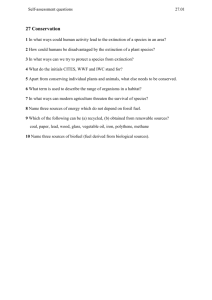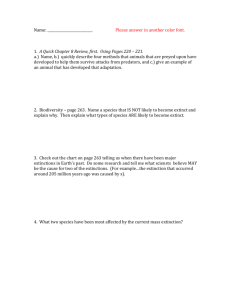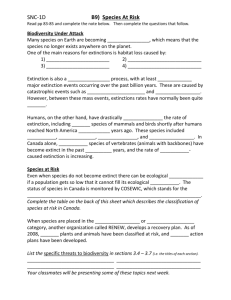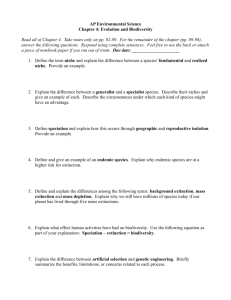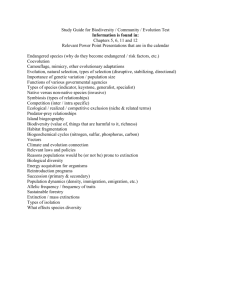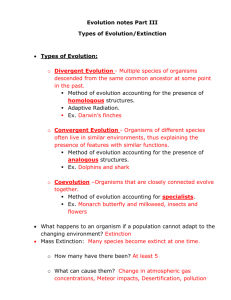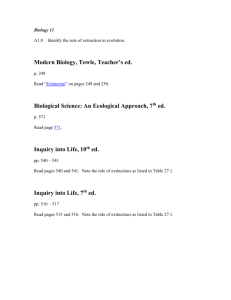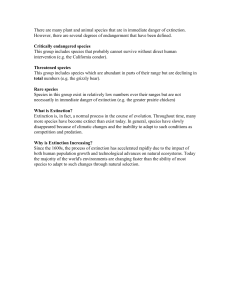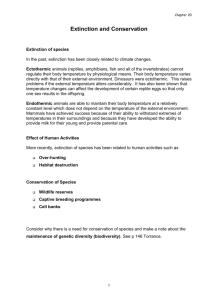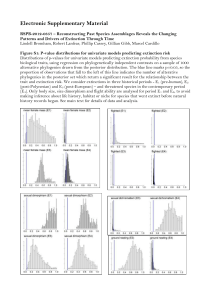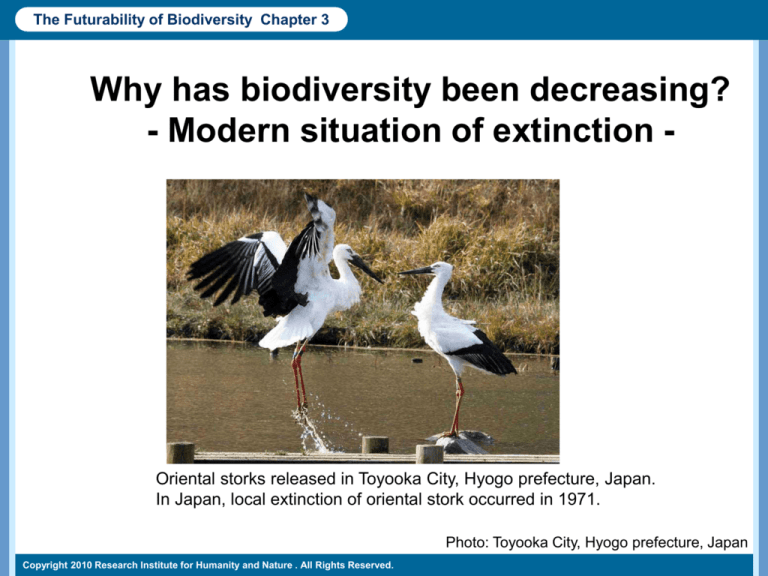
The Futurability of Biodiversity Chapter 3
Why has biodiversity been decreasing?
- Modern situation of extinction -
Oriental storks released in Toyooka City, Hyogo prefecture, Japan.
In Japan, local extinction of oriental stork occurred in 1971.
Photo: Toyooka City, Hyogo prefecture, Japan
Copyright 2010 Research Institute for Humanity and Nature . All Rights Reserved.
In Review
The present biodiversity is the result of evolution
Various organisms on the present earth are the
result of long-term evolution which has been
affected by environment and interspecific
interactions.
Copyright 2010 Research Institute for Humanity and Nature. All Rights Reserved.
Today’s Topics
1. What is extinction?
To what extent has the present biodiversity been
degrading?
2. Reasons for extinction
What are the reasons for extinction?
Photo: (first and third from right)
Copyright 2010 Research Institute for Humanity and Nature. All Rights Reserved. Echigo-Matsunoyama Museum of Natural Science, ‘kyororo’
1. What is extinction?
To what extent has the present biodiversity been
degrading?
1) Definition of extinction
2) The world’s Red List
3) Characteristics of modern extinction
Copyright 2010 Research Institute for Humanity and Nature. All Rights Reserved.
1. What is extinction? 1) Definition of extinction
Extinct (EX)
There is no reasonable doubt that the last individual has died:
Exhaustive surveys in known and/or expected habitat, at
appropriate times (diurnal, seasonal, annual), throughout its
historic range have failed to record an individual.
Dodo
(Raphus cucullatus)
Copyright 2010 Research Institute for Humanity and Nature. All Rights Reserved.
Thylacine
(Thylacinus cynocephalus )
Photo: (left) Bristol City Museum, Nature Picture Library
(right) Zoological Society of London
1. What is extinction? 1) Definition of extinction
Extinct in the wild (EW)
EW is known only to survive in cultivation, in captivity or as a
naturalized population(s) well outside the past range:
Exhaustive surveys in known and/or expected habitat, at
appropriate times (diurnal, seasonal, annual), throughout its
historic range have failed to record an individual.
Hawaiian Crow
(Corvus hawaiiensis)
Scimitar-horned Oryx
(Oryx dammah)
Photo: (left) Jack Jeffrey
(right) Ariadne Van Zandbergen, The Africa Image Library
Copyright 2010 Research Institute for Humanity and Nature. All Rights Reserved.
1. What is extinction? 1) Definition of extinction
Critically Endangered (CR)
CR is considered to be facing an extremely high risk of
extinction in the wild (See Column 1 in detail).
Lowland Gorilla
Axolotl
(Gorilla gorilla)
(Ambystoma mexicanum)
Copyright 2010 Research Institute for Humanity and Nature. All Rights Reserved.
Photo: (left) Bruce Davidson, Nature Picture Library
(right) Nick Barwick, Nature Picture Library
1. What is extinction? 1) Definition of extinction
Endangered (EN)
EN is considered to be facing a very high risk of extinction in
the wild (See Column 1 in detail).
Orangutan
Oriental Stork
(Pongo pygmaeus)
(Ciconia boyciana)
Copyright 2010 Research Institute for Humanity and Nature. All Rights Reserved.
Photo: (right) Toyooka City, Hyogo prefecture
1. What is extinction? 1) Definition of extinction
Vulnerable (VU)
VU is considered to be facing a high risk of extinction in the
wild (See Column 1 in detail).
Monkey Puzzle Tree
Hippopotamus
(Araucaria araucana)
(Hippopotamus amphibius)
Copyright 2010 Research Institute for Humanity and Nature. All Rights Reserved.
Photo: (left) Gabriel Rojo, Nature Picture Library
(right) Phyllis Greenberg, Animals Animals
1. What is extinction? 1) Definition of extinction
Near Threatened (NT)
NT is close to qualifying for a threatened category in the near
future.
Great Hornbill
African Elephant
(Buceros bicornis)
(Loxodonta africana)
Copyright 2010 Research Institute for Humanity and Nature. All Rights Reserved.
Photo: (left) Shumpei Kitamura
(right) Tony Heald, Nature Picture Library
Column 1: The criteria for CR, EN and VU
Evaluation of the threatened species
Each species is evaluated according to these five criteria,
then categorized by quantitative thresholds.
1. Population reduction
2. Restricted geographic range
3. Small population size and decline
4. Very small or restricted population
5. Quantitative analyses
Copyright 2010 Research Institute for Humanity and Nature. All Rights Reserved.
(IUCN 2001)
Column 1: The criteria for CR, EN and VU
Examples of quantitative thresholds
Criteria
CR
EN
VU
Reduction in population size in the
last/next 10 years or three
generations, whichever is the longer
≥80-90 %
≥50-70 %
≥30-50 %
<5000km2
and
<500km2
<20000km2
and
<2000km2
<250
<1000
Geographic range (extent of
occurrence and area of occupancy)
Population size
(number of mature individuals)
Probability of extinction in the wild
<100km2
and <10km2
<50
≥50% in 10 ≥20% in 20
years or 3
years or 5
generations generations
≥10% in
100 years
*More detailed explanation appears in IUCN Red List Categories and Criteria (2001)
Copyright 2010 Research Institute for Humanity and Nature. All Rights Reserved.
(IUCN 2001)
Column 2: Other categories
Least Concern (LC)
LC does not qualify for CE, EN, VU or NT. Widespread and
abundant taxa are included in this category.
Data Deficient (DD)
There is inadequate information to assess the risk of extinction.
Not Evaluated (NE)
Any species which has not yet been evaluated for risk of
extinction is categorized as NE.
Copyright 2010 Research Institute for Humanity and Nature. All Rights Reserved.
1. What is extinction? 2) The world’s Red List
Number of threatened species in major taxonomic group
Taxonomic
group
Vertebrates
Mammals
Number of
described
species
Number of
species
evaluated
Number of
threatened
species
Number threatened
as % of species
evaluated
5488
5488
1141
21%
Birds
9990
9990
1222
12%
Reptiles
8734
1385
423
31%
Amphibians
6347
6360
1905
30%
30700
3481
1275
37%
950000
1259
626
50%
Mosses
16000
95
82
86%
Ferns and allies
12838
211
139
66%
980
910
323
33%
258650
10779
7904
68%
Fishes
Invertebrates
Insects
Plants
Gymnosperms
Angiosperms
Copyright 2010 Research Institute for Humanity and Nature. All Rights Reserved.
(Jean et al. 2008)
Column 3: Extinction means not only extinction of species.
Oriental stork
breeding area
wintering area
local extinction
Copyright 2010 Research Institute for Humanity and Nature. All Rights Reserved.
Photo: Toyooka City, Hyogo prefecture
1. What is extinction? 3) Characteristics of modern extinction
Number of families of marine organisms
Fluctuation in number of families of marine organisms from
Paleozoic to date
800
600
400
200
Paleozoic
Mesozoic
Cenozoic
0
600
500
400
300
200
Number of past years (×million)
Copyright 2010 Research Institute for Humanity and Nature. All Rights Reserved.
100
0
(May et al. 1995)
1. What is extinction? 3) Characteristics of modern extinction
What is different in modern extinction from those
which happened in geologic time?
1) Pace
the late Mesozoic
a species per 1000 years
(underestimated)
1600 to 1900 A.D.
a species per four years
recent years
tens of thousands per year
2) Reasons
Extinction in geologic time
Volcanic eruption, Collision of huge meteorite
Drastic climate changes
Modern extinction
Copyright 2010 Research Institute for Humanity and Nature. All Rights Reserved.
Human activities
Summary 1. What is extinction?
Extinction means the phenomenon in which a
species is not found in the wild. Threatened species
are categorized into four groups, according to the
degree of the risk of extinction.
Many species in the world are categorized as
threatened species.
Modern extinction is greatly different from that in
geologic time in that its pace is much faster and
human activities cause the extinction.
Copyright 2010 Research Institute for Humanity and Nature. All Rights Reserved.
2. Reasons for extinction
What are the reasons for extinction?
1) Habitat loss due to human activities
2) Overuse of biological resources
3) Increase of alien species
4) Changes in human lifestyle and maintenance
of ecosystem
5) Climate change - global warming
Copyright 2010 Research Institute for Humanity and Nature. All Rights Reserved.
2. Reasons for extinction 1) Habitat loss due to human activities
Habitat loss due to human activities
・Logging of forests
⇒ Chapter 4
・Reclamation of wetlands
・Conversion from primary forest to farmland,
secondary forest and plantation forest
⇒ Chapter 4
・Fragmentation and isolation of habitats by development
⇒ Chapter 5
・Development of rare ecosystems
(environmentally destructive development of tropical
rainforest, coral reef, etc.)
Copyright 2010 Research Institute for Humanity and Nature. All Rights Reserved.
2. Reasons for extinction 1) Habitat loss due to human activities
Reclamation of wetlands - Isahaya Bay, Japan
History of reclamation
in the process
before 20-90 years
before 90-150 years
before 150-200 years
before 200-300 years
before 300 years
Copyright 2010 Research Institute for Humanity and Nature. All Rights Reserved.
http://www.maff.go.jp/kyusyu/nn/isahaya/outline/history01.html
2. Reasons for extinction 1) Habitat loss due to human activities
Development of rare ecosystems
- Damage to coral reef
Photo: Georg Heiss
(http://www.reefbase.org)
Copyright 2010 Research Institute for Humanity and Nature. All Rights Reserved.
Photo: Yu Umezawa
2. Reasons for extinction 2) Overuse of biological resources
Overuse of biological resources
・Eradication of harmful animals
- Japanese wolf, Tasmanian tiger, etc.
・Intensive fishery
- smelt, tuna, blue whale
・Excessive hunting of rare species for
commercial use
- Tiger (fur, bone), orchid (decorative plant)
Copyright 2010 Research Institute for Humanity and Nature. All Rights Reserved.
2. Reasons for extinction 2) Overuse of biological resources
Eradication of harmful animals
Japanese wolf was eradicated in 1905 because of hunting.
Copyright 2010 Research Institute for Humanity and Nature. All Rights Reserved.
Photo: taken by Hidefumi Kuwabara, owned by Wakayama University
2. Reasons for extinction 2) Overuse of biological resources
Intensive fishery – example of tuna
Catch (tons)
Change in catch of major species of tuna in the world
Skipjack
Yellowfin tuna
Bigeye tuna
Albacore
Data: Fig.3 from the tuna fishing industry and resource survey (general remarks)
International fishery resource of the 2008 fiscal year.
(National Research Institute of Fisheries Science, Fisheries Research Agency)
Photo: Mark Stouffer, Animals Animals
Copyright 2010 Research Institute for Humanity and Nature. All Rights Reserved.
2. Reasons for extinction 2) Overuse of biological resources
Excessive hunting of rare species
Population decreased because of poaching for commercial
fur and bones.
Copyright 2010 Research Institute for Humanity and Nature. All Rights Reserved.
2. Reasons for extinction 3) Increase of alien species
What is ‘alien species’?
Organisms newly introduced to an area by human
beings, including reproductive organs such as
seeds, eggs, gametes and asexual reproductive
organs.
How have alien species invaded?
Intentional introduction
Introduced species for food materials, livestock feeds, decorative
purposes, recreational purposes, biological control, etc.
Unintentional introduction
Species introduced by chance, attached to imports such as timbers, or
tourists’ shoes.
Commercial pets
Species imported as pets.
Copyright 2010 Research Institute for Humanity and Nature. All Rights Reserved.
2. Reasons for extinction 3) Increase of alien species
Influence of alien species on biodiversity
Alien species….
1. prey upon native species.
2. compete with native species for resources.
3. produce a hybrid with native species.
4. spread parasites or diseases to native, closelyrelated species.
Copyright 2010 Research Institute for Humanity and Nature. All Rights Reserved.
2. Reasons for extinction 3) Increase of alien species
Density of native
small-sized carp
Density of native
small-sized carp
1. Alien species prey upon native species.
- example of irrigation ponds in Japan
Density of bluegills
Density of black bass
Native fishes disappeared from ponds which
Illustration: Riyo Hirasawa
alien species invaded.
(Yonekura, Kita & Yuma 2004)
Copyright 2010 Research Institute for Humanity and Nature. All Rights Reserved.
2. Reasons for extinction 3) Increase of alien species
2. Alien species compete with native species for
resources.
Tall goldenrod
European bumblebee
(Solidago altissima)
(Bombus terrestris)
Alien species deprive native ones of resources (light, food) and drive them
from the habitat, because their reproduction is more intensive and survival
rate is larger than those of native species.
Copyright 2010 Research Institute for Humanity and Nature. All Rights Reserved.
Photo: (right) Koichi Goka
2. Reasons for extinction 3) Increase of alien species
3. Alien species produce a hybrid with native
species.
Hybrid (male) between Japanese Dorcus titanus (male) and exotic species
(female), which is larger than Japanese Dorcus titanus.
Copyright 2010 Research Institute for Humanity and Nature. All Rights Reserved.
Photo: Koichi Goka
2. Reasons for extinction 3) The increase of alien species
The problem of hybridization
1.Gene disturbance in native population
Each local population has adapted to its environment for a
long time, so hybridization lowers fitness of the native
population. Moreover, this decrease of fitness of the native
population lowers the effect of ecological functions in which
the population is involved.
2. Depreciation of historical value of local population
Each species or local population is an information source
of biological history or environmental changes in the earth.
Gene disturbance by hybridization depreciates the value of
the local population as historical inheritance.
Copyright 2010 Research Institute for Humanity and Nature. All Rights Reserved.
2. Reasons for extinction 3) Increase of alien species
4. Alien species spread parasites or diseases to
native closely-related species.
Alien species are agents of new parasites or disease.
Copyright 2010 Research Institute for Humanity and Nature. All Rights Reserved.
Photo: Koichi Goka
2. Reasons for extinction 3) Increase of alien species
Three Principles of Prevention
1. Don’t introduce alien species.
Don’t introduce alien species which may damage
endemic species.
2. Don’t abandon your pet.
Don’t leave alien pets in the wild.
3. Don’t extend the distribution of alien species.
Don’t increase distribution of alien species which have
already been established in the wild.
Copyright 2010 Research Institute for Humanity and Nature. All Rights Reserved.
2. Reasons for extinction 3) Increase of alien species
Does establishment of alien species always
damage domestic species?
Alien plants are often important food resources for
endemic bumblebees, because endemic plants have
been decreasing due to development by humans.
In such a case, should we remove the alien species?
Copyright 2010 Research Institute for Humanity and Nature. All Rights Reserved.
2. Reasons for extinction 4) Changes in human lifestyle and maintenance of ecosystem
Satoyama
- traditional landscape of agricultural villages in Japan
- mosaic structure of diverse vegetation
- high biodiversity preserved by human maintenance
Secondary forest
The trees around
a village shrine
Irrigation pond
Field
Grassland
Paddy field
Waterway
Copyright 2010 Research Institute for Humanity and Nature. All Rights Reserved.
(See Chapter 4 in detail)
2. Reasons for extinction 4) Changes in human lifestyle and maintenance of ecosystem
Satoyama and biodiversity
49% of areas in which endangered species of animals are
concentrated are categorized into satoyama ecosystems.
55% of areas in which endangered species of plants are
concentrated are categorized into satoyama ecosystems.
Copyright 2010 Research Institute for Humanity and Nature. All Rights Reserved.
2. Reasons for extinction 4) Changes in human lifestyle and maintenance of ecosystem
Human activities in satoyama
Taking of firewood
Gathering fallen leaves
The burning of a field
Leveling a paddy field
Photo: (upper right) Natural Museum in Geihoku - Katsunobu Shirakawa
Copyright 2010 Research Institute for Humanity and Nature. All Rights Reserved.
2. Reasons for extinction 4) Changes in human lifestyle and maintenance of ecosystem
Crisis of satoyama ecosystem
Changes in Secondary forest
Secondary forest where people still
take firewood and gather fallen leaves
Secondary forest where people
stopped taking firewood and gathering
fallen leaves
In many satoyama ecosystems, people have stopped
maintenance of secondary forests because of the conversion
from firewood to fossil fuels.
Copyright 2010 Research Institute for Humanity and Nature. All Rights Reserved.
2. Reasons for extinction 5) Climate change - Global warming
Difference in average temperature
compared to that from 1861 to 1990 (ºC)
Temperature of the earth has been increasing.
0.6
Changes in average temperature of the earth
(recent 140-year period)
0.4
0.2
0.0
-0.2
-0.4
1860
1880
1900
1920
year
Copyright 2010 Research Institute for Humanity and Nature. All Rights Reserved.
1940
1960
1980
2000
http://www.jccca.org/
2. Reasons for extinction 5) Climate change - Global warming
The concentration of CO2 is also rising on a global scale.
Concentration of CO2 (ppm)
Change in concentration of CO2 in the air (past 50 years)
Mauna Loa in Hawaii
Ryori in Japan
The South Pole
Global warming
year
The rise in the temperature caused by the rise in the
concentration of CO2 in the air.
Copyright 2010 Research Institute for Humanity and Nature. All Rights Reserved.
http://www.jccca.org/
2. Reasons for extinction 5) Climate change - Global warming
Global warming has a great influence on survival
of species.
If the average temperature of the earth rises 1.5
to 2.5º C, 20 to 30% of earth’s species will be in
danger of extinction (IPCC, 2007).
Some signs of the influences have been already
observed.
Copyright 2010 Research Institute for Humanity and Nature. All Rights Reserved.
2. Reasons for extinction 5) Climate change - Global warming
Damage to Ecosystem - coral death
1 to 3º C rises of seawater temp. increase coral reef damage.
Copyright 2010 Research Institute for Humanity and Nature. All Rights Reserved.
Photo: Yasunori Maezono
2. Reasons for extinction 5) Climate change - Global warming
The danger of extinction in a cold region - polar bear
Copyright 2010 Research Institute for Humanity and Nature. All Rights Reserved.
Photo: Yasunori Maezono
2. Reasons for extinction 5) Climate change - Global warming
The danger of extinction in alpine species - snow grouse
Copyright 2010 Research Institute for Humanity and Nature. All Rights Reserved.
Photo: International Nature and Outdoor Activity College
Summary 2. Reasons for extinction
Human activities bring habitat loss or fragmentation, which
is one of the reasons for extinction.
Some species have been threatened by intensive hunting.
Some native species have been decreasing because of
influential alien species.
Changes in human lifestyle are also involved with the
decrease of organisms.
Drastic climate change such as global warming has greatly
influenced biological extinction.
Copyright 2010 Research Institute for Humanity and Nature. All Rights Reserved.
Summary of Today’s Topics
Why has biodiversity been decreasing?
1. Biological extinction has been repeated from remote
antiquity. However, modern extinction is greatly different
from that in ancient times in that its speed is much faster
and its reason is mainly human activity.
2. The reasons for modern extinction consist of the following
five factors: habitat loss due to human activities, overuse
of biological resources, increase of alien species, changes
in human lifestyle and ecosystem maintenance and
climate change such as global warming.
Copyright 2010 Research Institute for Humanity and Nature. All Rights Reserved.
Exercises
Let’s do the exercise below.
1) What’s wrong with introducing alien species?
Hypothesis: High biodiversity (large number of species) is desirable.
Question: Two alien species, black bass and bluegill, were introduced
in Lake Biwa, Japan. As a result, an endemic species of cyprinid
was eradicated. In such a case, the number of species that live in
Lake Biwa increased by one species. Is this desirable or not?
+
+
-
=
+ 1 species
Copyright 2010 Research Institute for Humanity and Nature. All Rights Reserved.
Illustration: Riyo Hirasawa
Exercises
Let’s do the exercise below.
2) Should we coexist with biodiversity?
Among the organisms in the earth, there are species which
harm human beings - for example, malaria parasites and
malaria-carrying mosquitoes.
Coexistence with biodiversity means coexistence with
these harmful organisms.
Then, should we coexist with biodiversity?
Copyright 2010 Research Institute for Humanity and Nature. All Rights Reserved.
Glossary (1/2)
Fishing method using dynamite
In a tropical area, some people set off dynamite in the sea, and catch all of the
fish which are stunned or killed by the explosion. Such a method destroys coral
reefs in the tropical sea, and is regarded as a problem from the view of
environmental conservation.
Red List
Lists of endangered species which are made in each area or country.
Endangered species are categorized by several levels according to the degree of
the danger of extinction.
Secondary forest
Forests whose natural succession is stopped by human activities such as
firewood gathering, charcoal making, etc.
The burning of a field
Burning dead plants of a field in winter for keeping the place as grassland. If the
place were left alone, it would gradually return to a forest.
Copyright 2010 Research Institute for Humanity and Nature. All Rights Reserved.
Glossary (2/2)
The Cenozoic era
Geologic era after the Mesozoic era, from 65 million years ago to the present.
The Cenozoic era consists of the Tertiary period and the Quaternary period.
Mammals have taken the place of dinosaurs and prospered. Human beings
evolved in the Quaternary period, two million years ago.
The Mesozoic era
Geologic era after the Paleozoic era, from 251 million to 65 million years ago.
The Mesozoic era consists of the Triassic, the Jurassic and the Cretaceous
periods. In the Mesozoic era, dinosaurs and ammonites prospered and
angiosperms also evolved.
The Paleozoic era
Geologic era after the Precambrian era, from 542 to 251 million years ago.
The Paleozoic era consists of the Cambrian, the Ordovician, the Silurian, the
Devonian, the Carboniferous and the Permian periods. Fish evolved in the
Ordovician, amphibians evolved in the Silurian, and the reptiles evolved
in the Devonian period.
Copyright 2010 Research Institute for Humanity and Nature. All Rights Reserved.
References
The IUCN Species Survival Commission (2001)
IUCN Red List Categories and Criteria Version 3.1
World Conservation Union
Jean C.V., Craig H.T. and Simon N.S. (eds) (2008)
Wildlife in a Changing World – An Analysis of the 2008 IUCN Red List of
Threatened Species - World Conservation Union
May M.R., Lawton H. J. and Stock E.N. (1995)
Assessing extinction rate. In Lawton H. J. and May M.R. eds., “Extinction Rates,”
pp.1-24, Oxford University Press, Oxford.
Yonekura R., Kita M. and Yuma M. (2004)
Species diversity in native fish community in Japan: comparison between noninvaded and invaded ponds by exotic fish. Ichthyological Research 51:176-179
Copyright 2010 Research Institute for Humanity and Nature. All Rights Reserved.
Cited Websites
Agricultural Administration Bureau of Kyushu
http://www.maff.go.jp/kyusyu/nn/isahaya/outline/history01.html
Fisheries Research Agency
http://kokushi.job.affrc.go.jp/index-2.html
Japan Center for Climate Change Actions
http://www.jccca.org/
The IUCN Red List of Threatened Species
http://www.iucnredlist.org/
World Fish Center
http://www.reefbase.org/
Copyright 2010 Research Institute for Humanity and Nature. All Rights Reserved.
Authors & Credits
The Futurability of Biodiversity Chapter 3
Why has biodiversity been decreasing?
- Modern situation of extinction Authors
Atsushi Ushimaru Satoshi Yamashita Takakazu Yumoto
Takeshi Baba Aya Hatada Stewart Wachs Martin Piddington
Application software
Microsoft PowerPoint®
Illustration & design
Be4°TECH
Koubou Yecoruka
Riyo Hirasawa
Photos
Agricultural Administration Bureau of Kyushu
AnimalsAnimals Ariadne Van Zandbergen in The Africa Image Library
Atsushi Ushimaru Aya Hatada Biodiversity Photos Bristol City Museum
Bruce Davidson Echigo-Matsunoyama Museum of Natural Science, ‘Kyororo’
Gabriel Rojo Georg Heiss Hidefumi Kuwabara
International Nature and Outdoor Activity College Jack Jeffrey
Katsunobu Shirakawa in Natural Museum in Geihoku Koichi Goka Mari Morino
Mark Stouffer Masahiro Aiba Mitsue Shibata Nature Picture Library Nick Barwick
Phyllis Greenberg Shumpei Kitamura Takuo Nagaike Tohru Nakashizuka
Tony Heald Toyooka City, Hyogo prefecture Yasunori Maezono Yu Umezawa
Wakayama University Zoological Society of London
Copyright 2010 Research Institute for Humanity and Nature. All Rights Reserved.

